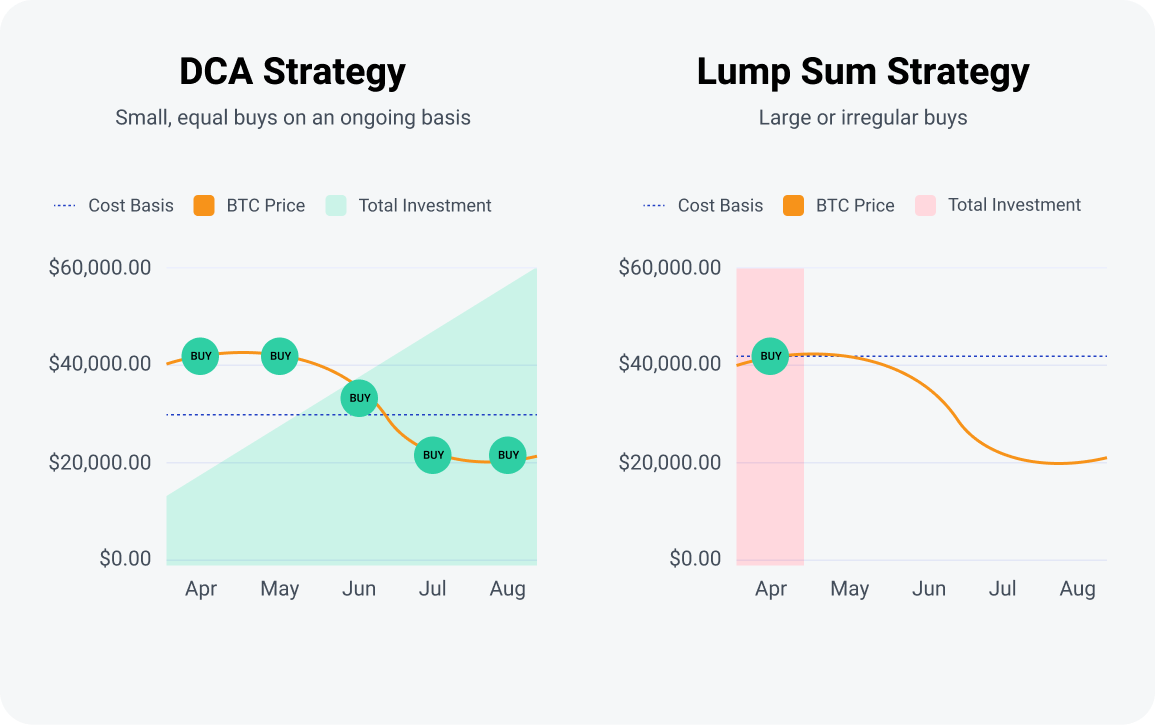In traditional finance, dollar-cost averaging (DCA) is an old investment strategy that involves buying a fixed amount of stocks on a regular basis, regardless of whether the price is high or low. This strategy allows you to lower the average purchase price of the stock. It is also a great way to remove some of the emotions from your investment decisions, and provides the opportunity for greater returns over time. But let’s take a look at how dollar-cost averaging applies to crypto assets.
What is Dollar Cost Averaging in Cryptocurrency?
Dollar-cost averaging (DCA) means making small, consistent investments instead of buying cryptocurrencies in large or irregular amounts. While cryptocurrencies can be significantly more volatile than stocks, dollar-cost averaging your cryptocurrencies can help you reap many of the same rewards that traditional stock traders enjoy. By regularly buying your favorite coins, you will automatically invest more over time, regardless of what happens in the crypto market. This allows you to increase your holdings and lower your overall cost basis when the market goes down.
🧠
A quick reminder: that Cost basis is the cost of the asset when you purchase it. If you purchase 1 Bitcoin for $50,000, your cost basis is $50,000.
How does dollar-cost averaging with cryptocurrencies work?
Let’s say you have $50,000 that you want to invest in cryptocurrency. If Bitcoin is currently priced at $50,000 and you made a lump sum investment now, you would own 1 Bitcoin for $50,000. However, if you spread that $50,000 over 5 equal $10,000 purchases at costs of $50,000/BTC, $45,000/BTC, $25,000/BTC, $25,000/BTC, and $55,000/BTC, your average cost basis would be $40,000 and you would have 1.4 Bitcoin. If Bitcoin goes up again, your gains will be magnified because you have lowered the average cost of acquiring your holdings. With dollar-cost averaging cryptocurrencies, you will end up owning more Bitcoin even during volatility.
How to use DCA cryptocurrency
Are you ready to try dollar cost averaging with crypto? The general idea of a regular buy is true, but there are a few things to consider before jumping in. Here’s how to DCA crypto like a pro.
- Select the asset you want to purchase
- Decide how often you want to purchase
- Decide on a rough amount to invest
- Choose a trusted provider/exchange to invest in
- Choose a safe and convenient place to store and manage your investments
Decide which token/cryptocurrency to purchase
If you are looking to start dollar-cost averaging future purchases of cryptocurrencies you already own, you probably already know which coins to target. If you are new to cryptocurrencies, it is wise to do thorough due diligence on any tokens you are considering acquiring, especially before attempting dollar-cost averaging.
How often do you invest?
Many exchanges offer automatic monthly, weekly, or in some cases, daily buy options. While recurring daily or weekly buys may not make much sense for assets that move slowly, such as traditional securities, the volatility of cryptocurrencies means you can use DCA strategies more frequently than you would for stocks. As always, make sure that the money you set aside for investing isn’t needed to pay your bills or house (unless you’re paying your bills with crypto).
How much are you willing to invest?
All investments carry risk, but given the extreme volatility of the cryptocurrency market, you should only invest what you can afford to lose. Dig into your monthly budget to figure out how much of your discretionary income you should invest in investments and make sure you don’t exceed that amount.
Where would you like to purchase it?
Many exchanges offer repeat purchases, which can be convenient. However, convenience comes at a cost. Exchanges don’t always offer the best rates, and they can add expensive fees to each purchase. Check rates regularly to see where you’re getting the best rates. BitPay offers cryptocurrency purchases without hidden fees, and shows you multiple offers to help you get the best rates.
Where will you keep your investment funds?
Deciding where to store your crypto safely is a personal decision. There are many different types of crypto wallets. If you use a custodial crypto wallet, make sure it has a solid reputation and a proven security track record. For advanced users who choose to self-store, there are many crypto wallets to choose from, including BitPay Wallet. BitPay Wallet offers market-leading security features such as self-custody, biometric security, multi-signature, and key encryption to not only keep your funds safe, but also open the door to a wide ecosystem of BitPay products and services, helping you get more utility from your holdings. Buy and exchange the most popular coins on BitPay to support your DCA crypto strategy.
Start your DCA strategy with BitPay
Buy cryptocurrency without hidden fees
DCA vs. lump sum investment
Whenever you invest a lump sum of money in an investment, the value of the asset you hold is fixed only for the ups and downs of the stock price (or coin price in the case of cryptocurrencies). However, using a dollar-cost averaging strategy, you can smooth out some of the price volatility over time by buying additional stocks when the market is down. As of 2022, we are in the midst of another crypto winter, which means asset prices are falling. A dollar-cost averaging strategy can be particularly profitable in these market conditions.

Potential Downsides of DCA Cryptocurrency Investments
Of course, there is no such thing as a completely foolproof investment strategy, and dollar-cost averaging cryptocurrencies can have some drawbacks and risks. Buying crypto automatically at regular intervals means that you can spend more money on smaller amounts of crypto when the market is going up. This has the opposite effect of DCA, and in fact, Lift up If there are multiple repeat purchases after a large uptrend, it is a cost basis. Some traders prefer to invest in a lump sum when the market is down in hopes of bigger profits, but to achieve such profits, you need to successfully time the market, which is very difficult when competing with automated and/or institutional traders.
Is the DCA Cryptocurrency Strategy Right for Me?
Using dollar-cost averaging in crypto is a consistent and simple way to build a portfolio, especially for beginners or those who don’t want to constantly be in front of a screen. If you want to invest more in crypto but are suffering from “analysis paralysis,” utilizing the DCA strategy can help you to immediately relieve anxiety and build a stable portfolio in the long term.
FAQs on DCA Strategy for Cryptocurrencies
How does dollar-cost averaging protect your investments?
By making recurring purchases over time in a fixed amount, you effectively remove all emotion from the investment equation. You may want to take a lump sum out of the market during a downtrend, even if you end up losing money as a result. However, if you sell all your holdings and the crypto you bought unexpectedly comes back to life, you could lose a lot of money.
How do you calculate dollar average cost?
If you’re not good at math, don’t worry. There are plenty of handy DCA calculators that allow you to simply input numbers to figure out how different purchases will affect your cost basis. This calculator from Omni is one of them. While it’s technically designed to calculate DCA for stock purchases, it can just as easily be used for cryptocurrency dollar-cost averaging.
How long should I use dollar-cost averaging strategy?
This depends on factors such as your investment horizon and financial goals. Ideally, a dollar-cost averaging strategy is something you can set and forget without having to constantly monitor your portfolio. However, true dollar-cost averaging is usually done over a long period of time, typically at least 6 to 12 months. After all, you can’t really average out a few data points.
How often should you use dollar cost averaging cryptocurrency strategy?
Dollar-cost averaging doesn’t have to be your entire cryptocurrency investment strategy. Some investors may use DCA for a portion of their holdings, even if most of their purchases are lump sums.
Is a lump sum investment in cryptocurrency better than dollar-cost averaging?
Both strategies have their pros and cons. While lump-sum investing offers the opportunity to make huge profits when a company’s stock price plummets and then soars, it is virtually impossible to determine the bottom of the market or predict where the stock will be in a few months or years. The same is true for cryptocurrency investing. Not only are cryptocurrencies more volatile than stocks, their prices can be affected by a variety of external and unpredictable factors. Depending on your risk tolerance and willingness to commit to a long-term investment plan, which method is right for you will depend on your level of risk tolerance and willingness to invest for the long term.
NOTE: All information in this article is provided for educational purposes only and should not be construed as investment advice. BitPay is not responsible for any errors, omissions or inaccuracies. The opinions expressed are solely those of the author and do not reflect the views of BitPay or its management. For investment or financial guidance, you should consult a professional.

